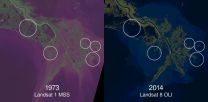(Press-News.org) Rabbits have long been considered immune to prion disease, but recently scientists have shown that they can--under certain circumstances--get transmissible spongiform encephalopathy (or TSE, the scientific term for the fatal brain disease caused by prions). Two studies published on August 6th in PLOS Pathogens address what makes rabbits hard to infect with prions and how their resistance can be overcome.
Prions are misfolded versions of a protein that, in its normal form (called PrPC, encoded by the PRNP gene), is found mainly in nerve cells of all mammals. The misfolded prions can trigger a domino effect by causing folding changes in their normal cellular counterparts, which turns them into toxic prions as well. Accumulation of toxic prions triggers the death of nerve cells and literally leaves holes in the brain, causing a spongiform (or sponge-like) appearance.
In one study, Joaquín Castilla, from CIC bioGUNE in Derio, Spain, and colleagues tested prion preparations from different species to see which ones could cause TSE in rabbits. To model the transmission barrier between rabbits and other species, they generated a transgenic mouse model that expressed the rabbit PRNP gene instead of the corresponding mouse gene.
The researchers then exposed these transgenic mice to prion isolates collected from sick animals, including classical and atypical strains of Bovine Spongiform Encephalopathy (i.e., mad cow disease), sheep Scrapie, and deer Chronic Wasting Disease. They found that the transgenic mice were susceptible to classical and atypical Bovine Spongiform Encephalopathy prions, and also to mouse-derived Scrapie prions.
These results provide further evidence that rabbits are susceptible to TSE following exposure to prions from several other species, and the researchers urge that "this information must be taken into account when assessing the risk of using ruminant derived protein as a protein source to feed rabbits."
Vincent Beringue, from INRA Virologie Immunologie Moléculaires in Jouy-en-Josas, France, and colleagues designed the second study to address what makes rabbits relatively resistant to prions. To clarify the respective roles of rabbit PrPC and non-PrP host factors in the rabbits' pronounced but not absolute resistance to TSE, they created transgenic rabbits that have both sheep and rabbit PRNP genes and tested their susceptibility to TSE. The sheep transgene they introduced into the rabbits coded for a version of sheep PrPC that is thought to be easily convertible to its toxic prion form.
Following exposure to sheep prions, all rabbits with the sheep PRNP transgene in addition to the full complement of rabbit genes (including rabbit PRNP) developed typical TSE after 6-8 months, whereas rabbits without the sheep PRNP transgene remained healthy more than 700 days after inoculation. Despite the presence of normal rabbit PrPC in the nerve cells, only sheep prions (i.e. the toxic misfolded form) were detectable in the brains of the diseased rabbits.
Beringue and colleagues conclude that their collective data demonstrate "that rabbits do not bear non-PrP factors that make them intrinsically resistant to prions." However, as the study by Castilla and colleagues suggests that the rabbit PRNP gene and its normal PrPC protein product do not act as absolute barriers to TSE development after exposure to prions from other species, they also acknowledge that "what exactly makes the rabbit species comparatively resistant to prion disease remains to be clarified."
INFORMATION:
Contact:
Joaquín Castilla
e-mail: castilla@joaquincastilla.com
phone: +34.61.868.2920
Vincent Beringue
e-mail: vincent.beringue@jouy.inra.fr
phone: +33.1.34.65.26.16
Please contact plospathogens@plos.org if you would like more information.
This news release is available in Japanese.
Today, many wealthy countries are able to mitigate, to some degree, their risk of delta flooding through vulnerability-reducing investments, but a new model suggests that this mitigation may not be sustainable in the long-term. Ultimately, wealthy countries could be feeling the strain of floods to a similar degree as developing countries. To calculate a given delta population's risk of flooding, Zachary Tessler and colleagues accounted for the population's probability of a damage-producing event, how the population's exposure ...
This news release is available in Japanese.
As a devastating earthquake ruptured Nepal on April 25, 2015, nearby GPS networks continuously recorded measurements at very close distances. In a new study, these data provide the scientific community with unique insights into megathrust earthquakes, which occur when two tectonic plates converge and one plate is forced underneath the other, and may help hazard assessment teams improve earthquake hazard models. To better understand the sudden and intense changes megathrust earthquakes entail, John Galetzka et al. analyzed ...
This news release is available in Japanese.
In the face of the recent Ebola outbreak, some good news emerges: a preclinical study testing the efficacy of the Ebola vaccine VSV-EBOV against the newly emerged West African Ebola strain shows complete protection when administered seven days before infection in nonhuman primates, and partial protection when administered three days before infection. The positive results of this study further reveal the mechanisms by which an effective immune response is mounted against the Ebola virus, aspects of which have been unclear. ...
Darwinian selection can be used to evolve robot controllers able to efficiently self-organize their tasks. Taking inspiration from the way in which ants organise their work and divide up tasks, Eliseo Ferrante and colleagues evolved complex robot behaviors using artificial evolution and detailed robotics simulations.
Just like social insects such as ants, bees or termites teams of robots display a self-organized division of labor in which the different robots automatically specialized into carrying out different subtasks in the group, says new research publishing in PLOS ...
Big data sets are important tools of modern science. Mining for correlations between millions of pieces of information can reveal vital relationships or predict future outcomes, such as risk factors for a disease or structures of new chemical compounds.
These mining operations are not without risk, however. Researchers can have a tough time telling when they have unearthed a nugget of truth, or what amounts to fool's gold: a correlation that seems to have predictive value but actually does not, as it results just from random chance.
A research team that bridges academia ...
Autopsies of nearly every patient with the lethal neurodegenerative disorder amyotrophic lateral sclerosis (ALS), and many with frontotemporal dementia (FTD), show pathologists telltale clumps of a protein called TDP-43. Now, working with mouse and human cells, Johns Hopkins researchers report they have discovered the normal role of TDP-43 in cells and why its abnormal accumulation may cause disease.
In an article published Aug. 7 in Science, the researchers say TDP-43 is normally responsible for keeping unwanted stretches of the genetic material RNA, called cryptic ...
For more than 20 years, Caltech geologist Jean-Philippe Avouac has collaborated with the Department of Mines and Geology of Nepal to study the Himalayas--the most active, above-water mountain range on Earth--to learn more about the processes that build mountains and trigger earthquakes. Over that period, he and his colleagues have installed a network of GPS stations in Nepal that allows them to monitor the way Earth's crust moves during and in between earthquakes. So when he heard on April 25 that a magnitude 7.8 earthquake had struck near Gorkha, Nepal, not far from Kathmandu, ...
Case Western Reserve scientists may have uncovered a molecular mechanism that sets into motion dangerous infection in the feet and hands often occurring with uncontrolled diabetes. It appears that high blood sugar unleashes destructive molecules that interfere with the body's natural infection-control defenses.
The harmful molecules -- dicarbonyls -- are breakdown products of glucose that interfere with infection-controlling antimicrobial peptides known as beta-defensins. The Case Western Reserve team discovered how two dicarbonyls -- methylglyoxal (MGO) and glyoxal (GO) ...
ROSEMONT, Ill.--According to a new study in the Journal of the American Academy of Orthopaedic Surgeons (JAAOS), imaging studies necessary to diagnose traumatic injuries sustained by pregnant women are safe when used properly.
During pregnancy, approximately 5 to 8 percent of women sustain traumatic injuries, including fractures and muscle tears. To help evaluate and manage these injuries, orthopaedic surgeons often recommend radiographs and other imaging studies. "While care should be taken to protect the fetus from exposure, most diagnostic studies are generally safe, ...
Women experience more emotional pain following a breakup, but they also more fully recover, according to new research from Binghamton University.
Researchers from Binghamton University and University College London asked 5,705 participants in 96 countries to rate the emotional and physical pain of a breakup on a scale of one (none) to 10 (unbearable). They found that women tend to be more negatively affected by breakups, reporting higher levels of both physical and emotional pain. Women averaged 6.84 in terms of emotional anguish versus 6.58 in men. In terms of physical ...

